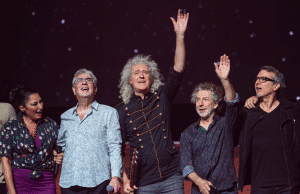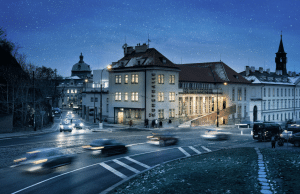With flatlining European economic forecasts contrasting starkly with surging Asian growth, this year’s CIBTM event in Beijing was a timely profile of China’s expanding MICE industry. Artemis Skordili and Rob Cotter were there to review the event and interview some key people on China’s progress and what South East Europe can learn from Asia’s success.
As the political seat of one of the world’s oldest continuous civilizations, Beijing is a living palimpsest of Chinese history. Having been renamed several times and twice had its ‘northern capital’ status revoked through dynastic change, since 1949 and the victory of Mao Zedong’s Communist Party of China (CPC) in the Chinese Civil War; it has performed its reinstated capital role with growing vigour and purpose.
A central pillar of Beijing’s capital responsibility is to develop China’s regional and international trade and tourism profile. One of the greatest tourist triumphs of recent years was the city’s hosting of the 2008 Olympic Games. The globally heralded games and the phenomenally high standard of the venues, accommodation and organisation were a clear signal of China’s economic ascent and Beijing’s confidence in hosting large-scale events.
Following the Olympics the Chinese economy has continued to strengthen, surpassing Japan to now sit behind the US, forecasts suggesting that it will displace the US over the next decade to become the world’s foremost economic power. With such rapid economic growth comes a heightened importance of the mechanics of successful enterprise. The potency of constructive meetings is a bedrock of this and Beijing is pivotal to the heart of the world’s single largest MICE market, one that, given the unprecedented pace and scale of the country’s growth, is at an early stage of a long and exciting journey.
The 6th CIBTM, held August 30th – Sep 1st 2011 in the China National Convention Centre (CNCC) was the prime place to get an overview of Beijing and China’s ambitions for its MICE standing in the region and beyond. Previously the Olympic International Broadcast and Main Press Centre, this imposing edifice was refitted post-Olympics and reopened as the CNCC in late 2009. With a plenary hall that can seat 5,700 delegates, a ballroom for up to 4,200 people, an auditorium for 350 delegates and approximately 100 small meeting rooms, this vast facility of 270,000m2 gross floor area is the largest of its kind in Asia. Its first full year of operation welcomed over 600 events – including 14 international exhibitions and 54 international conferences – that saw more than 700,000 visitors cross the building’s threshold. This year these figures are set to be eclipsed.
Some of the statistics of the 2011 CIBTM are further indications of the strength of the industry’s growth: with almost 400 exhibitors and over 300 hosted buyers, up 21% and 25% respectively, this year’s event was the biggest to date. In addition to this there were more than 7,000 pre-scheduled appointments, a sharp rise on 2010 figures. Running parallel to the exhibitions was an impressive education programme – ‘China Meetings Week’ – which included both SITE and ICCA events as well as three highly informative and popular sessions from Meeting Professionals International (MPI), two of which were CMP accredited.
Such notable growth and a focus on improvement through education is unsurprising, being heavily supported by both the China National Tourist Administration and Beijing Municipal Government. In setting out targets for CIBTM, Mr Sun Weijia, Vice Director of the Beijing Municipal Commission of Tourism Development, stated that “we will strive to make CIBTM the top event for the MICE industry in the Asia-Pacific region within five years.”
Going by the figures to date, they are well on their way to achieving this and a solid framework is in place to ensure they do. The CNCC is an ideal spot, equidistant from both city centre and airport. The building adjoins an area that is now Chinaʼs most popular tourist attraction: the Olympic Green area with the Bird’s Nest stadium, the National Indoor Stadium and the Water Cube. Being a flexible facility able to cater for any size of event within a popular hub, it is perfect for hosting the growing demands of CIBTM.
Moreover, whilst there are a number of top international hotels in the close vicinity (and one directly adjoining the CNCC), for visitors desiring the absolute pinnacle of service the locale now boasts one of only three 7-star hotels in the world. The Pangu Hotel, designed by renowned architect C.Y. Lee, directly overlooks the Birdʼs Nest stadium and offers unparalleled ‘presidential’ levels of service in its opulent surroundings, with iconic night-time views from its two roof terraces. An exquisite accommodation experience, it also has two ballrooms and seven meeting rooms, should more intimate post-exhibition facilities be required. Such meetings can, if needed, also be continued and closed in one of the hotel’s 26 sumptuous private dining rooms.
Beyond the CNCC, Beijing also has a number of other high-quality venues and an incredible hotel offer, stretching well beyond the 200,000 room mark distributed across 778 star-rated hotels (3* and higher). There is the 77,000m2 Beijing International Convention Centre (BICC) catering for up to 2,500 delegates; the China World Trade Centre; the National Agricultural Exhibition Centre (NAEC) and Beijing Exhibition Centre (BEC); and recently the New China International Exhibition Centre (NCIEC), with 100,000m2 of exhibition space as well as a shopping mall, hotels and convention and meeting space.
In spite of such extant wealth of infrastructure, China’s potential for growth is recognised as the greatest in the world and its litmus test will ultimately be success in the capital. It will therefore be essential for external event organisers to work closely with Beijing authorities – and here lies the first major challenge. To date Beijing still does not have a CVB in place, an anomaly for a city of this scale.
“By the end of the year, the policy will be done and a CVB will be set up with a specific group of people to assist professional companies bringing events to Beijing,” assured Mr Sun Weijia. “This will include preferential policies to encourage development of the local MICE industry. We will also encourage international organisations and companies to be installed in Beijing and work from Beijing. We may also facilitate administrative and logistic procedures and support local companies in bidding for international events. There may also be subsidies by way of financial support.”
“It is important to remember,” added Mr Sun Weijia, “that Beijing has unique advantages for MICE resources: transport, infrastructure and education are all in place for the acceleration of the MICE industry.”
In addition to these advantages, the benefits of developing a close relationship with the Beijing Tourist Administration (BTA) and forthcoming CVB may also be to access venues that can significantly raise the profile of an event – these could include networking functions at the Great Wall, the Forbidden City, the Summer Place and a number of amazing venues on Beijing’s cultural map. The BTA is addressing policy and regulation barriers to many public monuments in an effort to increase the register available for functions, further increasing the attractiveness of the city’s event profile.
Despite an abundantly diverse supply of convention centres, accommodation and potential networking venue highlights, there are challenges ahead for both Beijing and China. These are both macro – such as visa complexities, strong regional competition and the need to nurture PMOs and PCOs – as well as micro, such as supporting city navigation for visitors and helping with translation services, including boosting English language availability. For all of these, initiatives are either under consideration or under way, making Beijing an operational catalyst with suitable innovation for problem-tackling that can be utilised across China.
2012 is the Chinese Zodiac’s ‘Year of the Dragon’, important in being both national symbol and zodiac sign signifying success. China’s economic growth is an unmitigated success: international awareness of a business presence in and developing stronger connections with China is increasing daily. The success of the CIBTM, with an eye on becoming Asia’s top MICE event within five years, will look forward to celebrating 2012ʼs Year of the Dragon with even more record-breaking figures. This is clearly China’s time. As capital city, it is clearly Beijing’s too.
Artemis Skordili is a TV reporter and freelance journalist based in Athens, Greece.
Rob Cotter is a freelance journalist based in London, UK.













